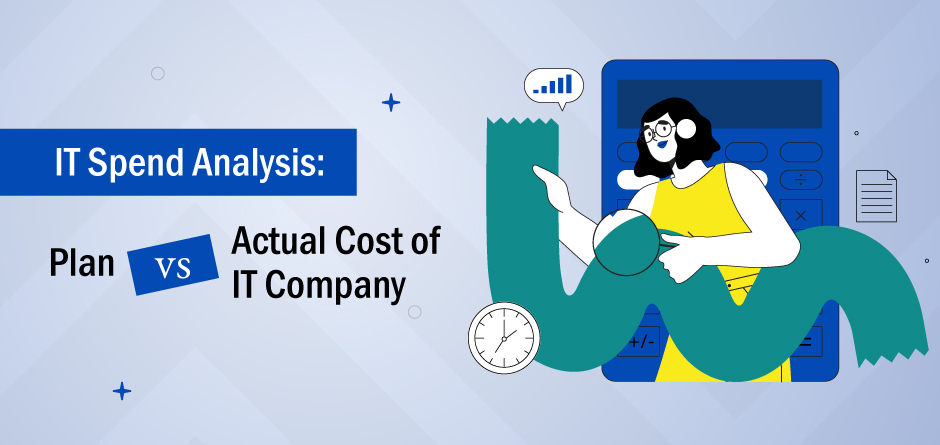
IT Spend Analysis: Plan vs Actual Cost of IT Company
Budgeting is one of the most critical financial activities for any business. When we talk of IT teams, it assumes much more importance. As technology changes rapidly, a slight variation in figures can negatively impact the company’s finances. It is thus crucial to make IT spend analysis a vital aspect of your planning process.
One of the best ways to do that is with the help of Microsoft Power BI. This article looks at how you can do IT spend analysis with Power BI and the related aspects you need to consider.
What is Spend Analysis?
Spend analysis is a process to decrease the cost and increase the efficiency of any company. It is a process to collect, clean, and classify the data dedicated to software or any one of the spend cubes.
Now let’s have a look at how to add spend analytics. You can select the data and turn and twist it to examine or identify the patterns, which you can use in your next strategy to plan further for the following year.
Now, let’s look at the difference between spend analysis and spend analytics.
Before you carry out the spend analysis, you need to do the spend analytics to identify the patterns and layout the strategies. With the help of the spend analytics, you can also do the spend analysis on it. This way, you will get a brief idea about the spend analysis.
With the help of spend analytics, you can identify various options like saving opportunities, managing the risk optimization of the organization’s buying power, and improving your company’s efficiency.
Thanks to spend analysis, you can improve visibility into the corporate spend, drive performance improvements, and most importantly, save costs.
Spend analysis has the following features: products, prices, quantities, players, business unit, and payment terms.
So how does this go into line? First of all, we think about what we’re going to buy, how much we pay for that product, the quantity purchased, whom we buy from, and finally who is buying a product and on what terms. These are the essential features of spend analysis that will help increase your company’s efficiency.
What are the different types of spend?
There are two types of spend. Let’s look at each in detail.
-
Direct spend
Direct spend refers to the goods and services directly related to the product. It includes things like raw material, hardware components, and many other services related to the product’s manufacturing process.
-
Indirect spend
Indirect spend refers to the sourcing of goods and services not indirectly related to product manufacturing. Here are a few examples of indirect spend categories:
- Marketing services
- Travelling expenditure
- Transportation and management
- Utilities like electricity, water, gas
- Hardware, software- IT services
- Consultancy, maintenance, repair, and operations
Spend analysis benefits
We can see what we have spent on which product in detail. It will help identify saving opportunities, align and streamline processes across business units, manage risk on spending to ensure compliance, increase supplier performance for better relationship management with the client, benchmark performance with the peers, and get data-driven sourcing.
How to Carry Out Spend-Analysis?
So here we will see how to do spend analysis, which differs in size and shape but has six key steps identical to spend analytics. First, we need to identify, extract, and cleanse it respectively. Then enrich, classify and finally analyze it. If there is any other problem, then again, we have to repeat all the six steps, and at last, you have the spend analysis ready.
What is Planning Actually?
Not everything goes according to plan; it’s mostly all about how it’s managed. The planned analysis includes the systematic plans for expenditures on the company by studying the monthly reports. By reading them, one can find whether the company is progressing or not. IT spend analytics means tracking the actual and planned results, so initially comparing them will make the difference. We have to find out the difference using spend analytics.
What is Plan vs. Actual?
A plan is an active preview of the financial results of the company. What actions do we need to take when reviewing the actual results? It is also known as variance analysis. It’s all about comparing the planned strategies for the results and the results that actually happened. The difference between them will help drive the business with better management.
Below is the graph from Power BI.
This comparison will help us understand the company as planned and investigate areas of the massive divide between the plan and the company’s actual performance. As you can see in the graph below, the plan variance analysis by month, business area, and country name.
The IT spend analysis dashboard below shows two tiles: variance plan percentage, variance latest estimate percentage, and property 3. It also shows that we are 6%, as the plan it answers is YTD ID spend trend analysis, why TD spend by cost elements and plan variance analysis and amount.
Bottom line
Power BI comes with a range of benefits that can help you streamline your company’s finances for the best results. Besides regulating costs, it will also help you plan better for the future. Wise planning will ensure that you do not go overboard with the spending. Well-planned financials will also enable a reduction in costs, leading to better business value.
Getting started with IT spend analysis on Power BI is simple. If you are looking for advanced support, our experts can help you. Leverage our expertise to get the maximum benefits from the Power BI platform Contact us today to know more details about our services.
RECENT POSTS
CATEGORIES
